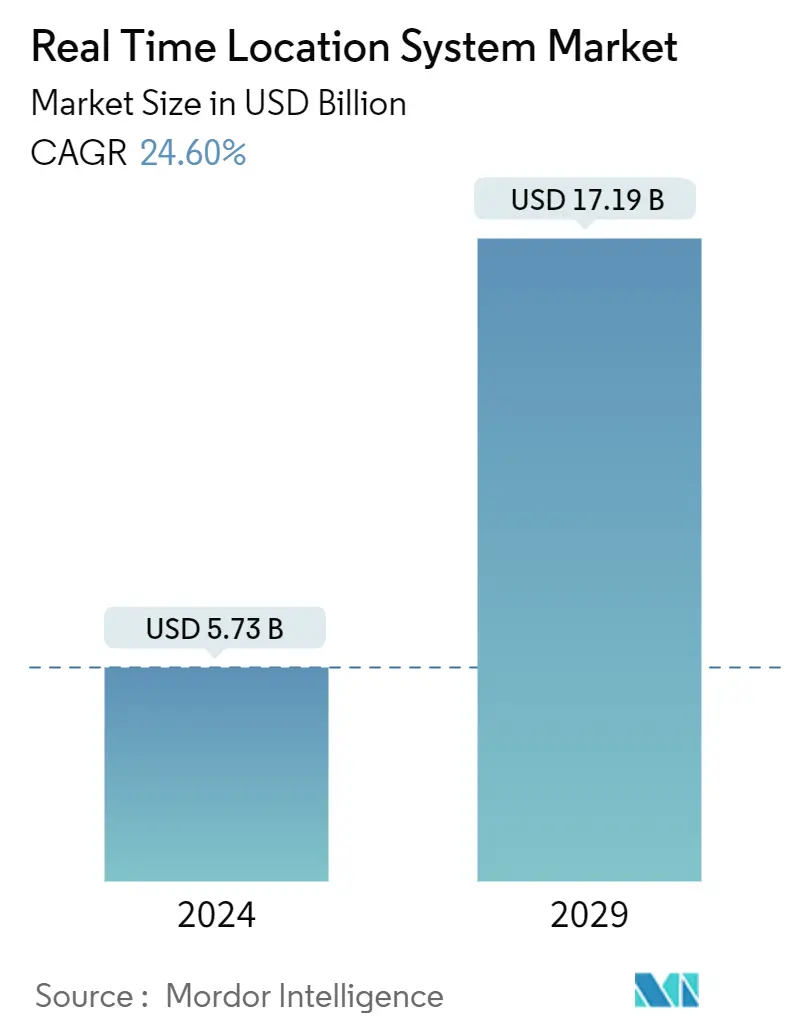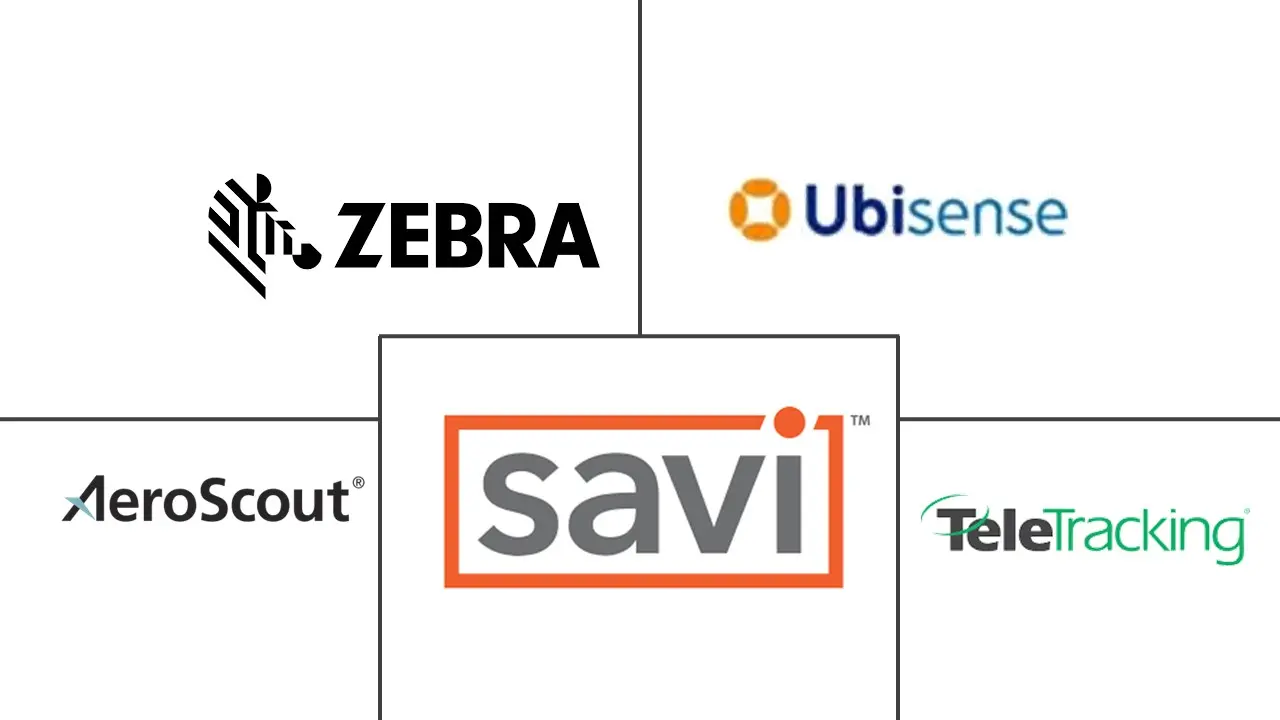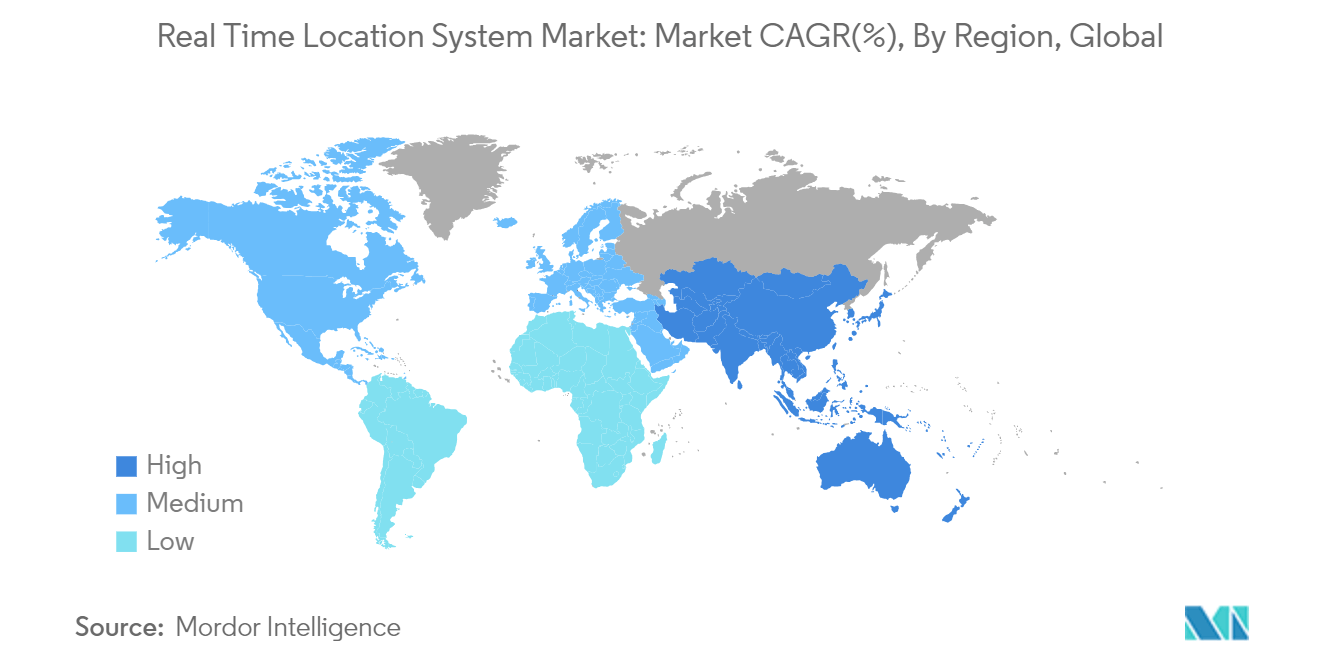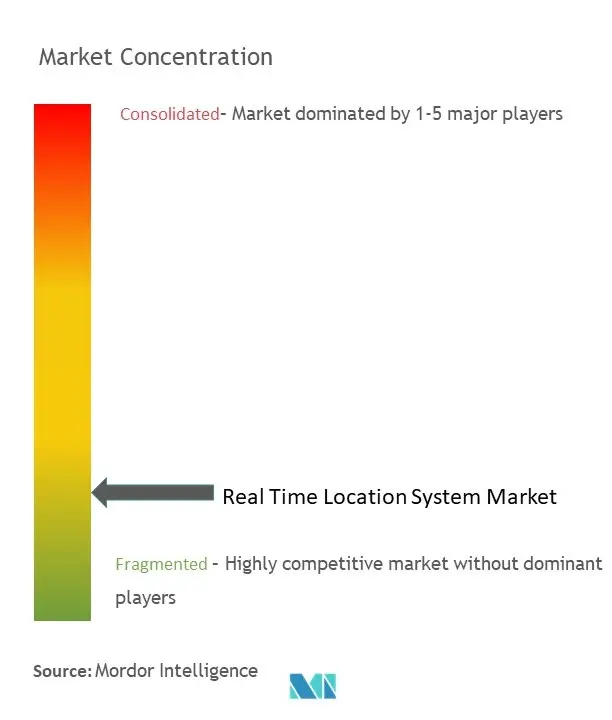Real Time Location System Market Size

| Study Period | 2019 - 2029 |
| Market Size (2024) | USD 5.73 Billion |
| Market Size (2029) | USD 17.19 Billion |
| CAGR (2024 - 2029) | 24.60 % |
| Fastest Growing Market | Asia Pacific |
| Largest Market | North America |
Major Players
*Disclaimer: Major Players sorted in no particular order |
Real Time Location System Market Analysis
The Real Time Location System Market size is estimated at USD 5.73 billion in 2024, and is expected to reach USD 17.19 billion by 2029, growing at a CAGR of 24.60% during the forecast period (2024-2029).
A real-time location system helps determine the current position of an object based on real-time information gathered through a wireless system. It helps in indoor tracking of the thing as well. Therefore, owing to the availability of indoor tracking, the healthcare sector is adopting this system, which is expected to contribute to the growth of the RTLS market for the healthcare vertical.
- For instance, according to Cisco, 500 billion devices are expected to be connected to the Internet by 2030. With the increasing trend of IoT and wearable devices, organizations can quickly get more things done, boosting productivity and delivering insight for better user experiences and engagement.
- Industries are opting for RTLS to lower the risk of workplace accidents. An RTLS helps to know the exact position of forklifts, vehicles, and operators at any given time. Based on the collected data, an RTLS analyzes the traffic, enabling it to identify and eliminate workplace accidents and eradicate workflow bottlenecks, saving time and money.
- RTLS can also be an effective way for hospitals to monitor their operations as insurance against potential lawsuits. Most hospitals have patient promises (for instance, how often staff checks up on patients and how often they receive medical attention). These are particularly common in patients with critical conditions or various mental illnesses. RTLS can be used as insurance against such lawsuits.
- The Bluetooth standard has been widely adopted worldwide. Bluetooth Low-Energy (BLE) solutions are cheaper and easier to integrate with existing systems and devices than other technologies. RTLS employing Bluetooth tags offers a detection accuracy of up to 1.5 meters (approximately 5 feet), making them suitable for diverse healthcare applications. High initial setup and maintenance costs are likely to hinder the market's growth during the forecast period.
- Owing to the outbreak of COVID-19, hospitals have been leveraging RFID technology to better manage patients and employees during the pandemic. RFID tools that use wireless communication to identify and track assets and equipment have witnessed a strong adoption in the healthcare sector. As public health emergencies continue, RFID drives care teams' efficiency and accountability.
Real Time Location System Market Trends
Healthcare Industry Offers Potential Growth
- With the increasing population and patients worldwide, patient safety has become a paramount and critical public health concern. According to WHO, medication errors are expected to cause one death per one million people in 2022. A population of 447 million equals 163,000 deaths per year in the EU. According to statistics from Spain, Germany, and the United States, between 60,000 and 131,000 people die in Europe yearly.
- Numbers from the World Health Organization state that there is a 1 out of 300 chance of a patient being harmed in healthcare due to medical errors. Most medical errors are attributed to adverse drug events, specimen misidentification, and incorrect blood transfusion, mainly caused by the misidentification of patients and medication. The Food and Drug Administration (FDA) has estimated that half of the medical errors caused by misidentification are preventable by introducing integrated IT infrastructure.
- At present, hospitals are facing unprecedented challenges with the ongoing pandemic. The other serious challenges the healthcare sector faces are aging populations and staff shortages that place enormous pressure on institutions, doctors, workers, patients, and communities.
- Doctors, hospitals, and clinics are looking for ways to cut costs and improve efficiency while still providing the quality of care their patients require. According to the WHO, the global healthcare workforce shortage could reach 14 million by 2030, with clinicians expected to face ever-increasing workloads.
- In addition to the financial challenges, there are safety challenges. In a hectic hospital environment, it cannot be guaranteed that every patient may be monitored at any time, leading to patients going unnoticed in dangerous situations. Hence, the demand for real-time location systems may grow in the coming years to manage and monitor patients in real time.
- Since the inception of RTLS, many industries have employed systems and benefitted from the reduced wastage of resources. RFID and Wi-Fi systems are currently the most-used devices in RTLS. With the sector actively adopting and moving toward Industry 4.0, connected devices, and IoT in manufacturing, the demand is expected to grow in the health industry.

Asia-Pacific to Witness the Fastest Growth
- The Asia-Pacific market is expected to grow at the fastest rate during the forecast period because of the increasing working population and the booming healthcare industry in emerging economies of the world, i.e., India and China.
- The growing adoption of Industry 4.0 and IoT in manufacturing in the Asia-Pacific region has fueled the implementation of RTLS systems. The healthcare, transportation and logistics, industrial production, government, and defense industries are at the edge of radio technology-based RTLS implementation.
- The Indian Brand Equity Foundation estimates that India's manufacturing sector has the potential to reach USD 1 trillion by 2025. As a result, RTLS has a huge opportunity in warehouse management, shipping, and logistics.
- According to Cisco Systems, in 2022, wearables used in Asia-Pacific are forecast to account for approximately 28.7% of the wearable 5G connections globally. Therefore, the increasing demand for wearables drives the growth of the real-time location system market.

Real Time Location System Industry Overview
The real-time location system market is highly fragmented. The major players include Zebra Technologies Corporation, Ubisense Group PLC, AeroScout Inc. (Stanley Healthcare), TeleTracking Technologies Inc., and Savi Technology. The companies see tremendous opportunities in developing regions, thus strategizing their operations accordingly with mergers and acquisitions or product innovations. Some of the key developments in the market are:
- April 2023 - Sewio, a UWB-based real-time location system vendor, disclosed the release of real-time lStudio version 3.1, which introduces Trackables. This feature paves the way to an interoperable, scalable, reasonable location market. Trackables allow the virtualization of tags, providing a faster, easier, and more efficient method for mirroring real-world shop floor operations.
Real Time Location System Market Leaders
-
Zebra Technologies Corporation
-
Ubisense Group PLC
-
AeroScout, Inc.
-
TeleTracking Technologies, Inc.
-
Savi Technology
*Disclaimer: Major Players sorted in no particular order

Real Time Location System Market News
- December 2023 - India has announced the launch of an app that will enable companies to track their cargo moving over land, rail, sea, and air, according to a report by the Economic Times (ET). The app has garnered interest from over 700 companies in courier, logistics, shipping, and manufacturing. These companies have signed up for the app that the government will launch soon.
- September 2023 - Logistics Giant Delhivery launched a location intelligence solution named LocateOnce.LocateOne is a location intelligence stack that operates through APIs, offering a range of features to enhance the accuracy of address data. It provides centralized, real-time order visibility and helps businesses cut costs by using their resources more efficiently.
Real Time Location System Market Report - Table of Contents
1. INTRODUCTION
- 1.1 Study Assumptions and Market Definition
- 1.2 Scope of the Study
2. RESEARCH METHODOLOGY
3. EXECUTIVE SUMMARY
4. MARKET INSIGHTS
- 4.1 Market Overview
-
4.2 Industry Attractiveness - Porter's Five Forces Analysis
- 4.2.1 Bargaining Power of Suppliers
- 4.2.2 Bargaining Power of Buyers/Consumers
- 4.2.3 Threat of New Entrants
- 4.2.4 Threat of Substitute Products
- 4.2.5 Intensity of Competitive Rivalry
- 4.3 Key Stakeholder Analysis
- 4.4 Assessment of COVID-19 Impact on the Market
5. MARKET DYNAMICS
-
5.1 Market Drivers
- 5.1.1 Need for Cost Reduction and Process Optimization
- 5.1.2 Rapid Adoption in the Healthcare Segment
- 5.1.3 Innovations in Tracking Technology and Recent Advancements in Fleet Tracking to Aid Growth
-
5.2 Market Challenges
- 5.2.1 Presence of Legacy Infrastructure Across End Users
- 5.2.2 Privacy and Security Concerns
-
5.3 Market Opportunities
- 5.3.1 Automated Contact Tracing to Mitigate the Spread of Community-related Diseases
6. MARKET SEGMENTATION
-
6.1 By End-user Vertical
- 6.1.1 Healthcare
- 6.1.1.1 Major Applications
- 6.1.1.2 Segmentation by Technology
- 6.1.1.2.1 Bluetooth
- 6.1.1.2.2 Wi-Fi
- 6.1.1.2.3 RFID
- 6.1.1.2.4 Ultra-wideband (UWB)
- 6.1.1.2.5 InfraRed (IR)
- 6.1.2 Manufacturing
- 6.1.2.1 Major Applications
- 6.1.2.2 Segmentation by Technology
- 6.1.2.2.1 Bluetooth
- 6.1.2.2.2 RFID
- 6.1.2.2.3 Wi-Fi
- 6.1.2.2.4 UWB
- 6.1.3 Retail
- 6.1.3.1 Major Applications
- 6.1.3.2 Segmentation by Technology
- 6.1.3.2.1 Wi-Fi
- 6.1.3.2.2 UWB
- 6.1.3.2.3 Bluetooth
- 6.1.4 Transportation and Logistics
- 6.1.4.1 Major Applications
- 6.1.4.2 Segmentation by Technology
- 6.1.4.2.1 RFID
- 6.1.4.2.2 UWB
- 6.1.4.2.3 Bluetooth
- 6.1.5 Government and Defense
- 6.1.5.1 Major Applications
- 6.1.5.2 Segmentation by Technology
- 6.1.5.2.1 RFID
- 6.1.5.2.2 UWB
- 6.1.6 Oil and Gas
- 6.1.6.1 Major Applications
- 6.1.6.2 Segmentation by Technology
- 6.1.6.2.1 RFID
- 6.1.6.2.2 UWB
-
6.2 By Component
- 6.2.1 Hardware
- 6.2.2 Software and Services
-
6.3 Geography
- 6.3.1 North America
- 6.3.2 Europe
- 6.3.3 Asia-Pacific
- 6.3.4 Latin America
- 6.3.5 Middle East and Africa
7. COMPETITIVE LANDSCAPE
-
7.1 Company Profiles
- 7.1.1 Zebra Technologies
- 7.1.2 Ubisense Group PLC
- 7.1.3 AeroScout Inc.
- 7.1.4 TeleTracking Technologies Inc.
- 7.1.5 Savi Technology
- 7.1.6 CenTrak Healthcare company
- 7.1.7 Ekahau Inc.
- 7.1.8 Midmark Corporation
- 7.1.9 Identec Group AG
- 7.1.10 Sonoitor Technologies Inc.
- 7.1.11 Awarepoint Corporation (Centrak Inc.)
- 7.1.12 Kontact.io
- 7.1.13 Alien Technology
- 7.1.14 Stanley Healthcare
- 7.1.15 Impinj
- *List Not Exhaustive
8. INVESTMENT ANALYSIS
9. MARKET OPPORTUNITIES AND FUTURE TRENDS
** Subject To AvailablityReal Time Location System Industry Segmentation
Real-time locating systems (RTLS) are used to automatically identify and track the location of objects or people in real-time, usually within a building or other contained area. The improved real-time tracking ability in diverse business processes boosts the real-time location systems market share. These systems provide increased productivity, accuracy, and operational excellence. Among the RTLS technologies, the demand for RFID tags has been increasing in the healthcare sector because RFID tags can be used in many forms, such as tracking surgical tools and patients and staff.
The real-time locating systems (RTLS) market is segmented by end-user vertical (healthcare, manufacturing, retail, transportation and logistics, government and defense, oil, and gas), component (hardware, and software and services), and geography (North America, Europe, Asia-Pacific, Latin America, Middle East & Africa). The market sizes and forecasts are provided in terms of value (USD) for all the above segments.
| By End-user Vertical | Healthcare | Major Applications | |
| Segmentation by Technology | Bluetooth | ||
| Wi-Fi | |||
| RFID | |||
| Ultra-wideband (UWB) | |||
| InfraRed (IR) | |||
| By End-user Vertical | Manufacturing | Major Applications | |
| Segmentation by Technology | Bluetooth | ||
| RFID | |||
| Wi-Fi | |||
| UWB | |||
| By End-user Vertical | Retail | Major Applications | |
| Segmentation by Technology | Wi-Fi | ||
| UWB | |||
| Bluetooth | |||
| By End-user Vertical | Transportation and Logistics | Major Applications | |
| Segmentation by Technology | RFID | ||
| UWB | |||
| Bluetooth | |||
| By End-user Vertical | Government and Defense | Major Applications | |
| Segmentation by Technology | RFID | ||
| UWB | |||
| By End-user Vertical | Oil and Gas | Major Applications | |
| Segmentation by Technology | RFID | ||
| UWB | |||
| By Component | Hardware | ||
| Software and Services | |||
| Geography | North America | ||
| Europe | |||
| Asia-Pacific | |||
| Latin America | |||
| Middle East and Africa |
Real Time Location System Market Research FAQs
How big is the Real Time Location System Market?
The Real Time Location System Market size is expected to reach USD 5.73 billion in 2024 and grow at a CAGR of 24.60% to reach USD 17.19 billion by 2029.
What is the current Real Time Location System Market size?
In 2024, the Real Time Location System Market size is expected to reach USD 5.73 billion.
Who are the key players in Real Time Location System Market?
Zebra Technologies Corporation, Ubisense Group PLC, AeroScout, Inc., TeleTracking Technologies, Inc. and Savi Technology are the major companies operating in the Real Time Location System Market.
Which is the fastest growing region in Real Time Location System Market?
Asia Pacific is estimated to grow at the highest CAGR over the forecast period (2024-2029).
Which region has the biggest share in Real Time Location System Market?
In 2024, the North America accounts for the largest market share in Real Time Location System Market.
What years does this Real Time Location System Market cover, and what was the market size in 2023?
In 2023, the Real Time Location System Market size was estimated at USD 4.32 billion. The report covers the Real Time Location System Market historical market size for years: 2019, 2020, 2021, 2022 and 2023. The report also forecasts the Real Time Location System Market size for years: 2024, 2025, 2026, 2027, 2028 and 2029.
Real Time Location System Industry Report
Statistics for the 2024 Real Time Location System market share, size and revenue growth rate, created by Mordor Intelligence™ Industry Reports. Real Time Location System analysis includes a market forecast outlook to 2029 and historical overview. Get a sample of this industry analysis as a free report PDF download.



